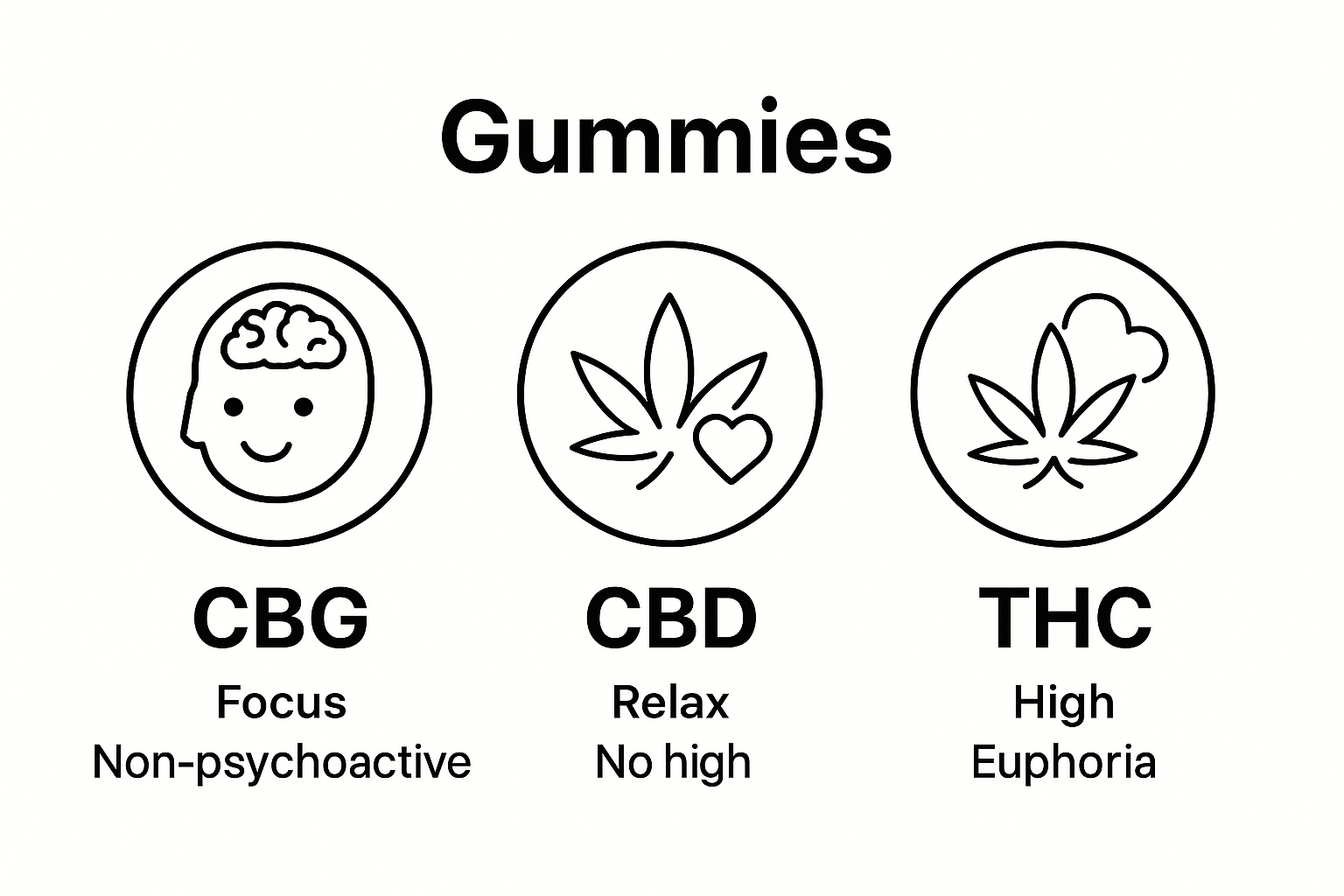Blog
What is CBG in Gummies? Understanding the Benefits
CBG is quickly becoming one of the most talked about compounds in cannabis science and people are starting to notice its unique effects. Most cannabis plants only have less than 1% CBG naturally which makes it far rarer than CBD or THC. Now, researchers are finding that this so-called ‘mother cannabinoid’ might have bigger health benefits than anyone expected.
Table of Contents
- Defining CBG: The Basics Of Cannabigerol
- Why CBG Matters: Health Benefits And Effects
- How CBG Works: Interactions With The Endocannabinoid System
- CBG In Gummies: What Sets Them Apart From Other Edibles
- The Future Of CBG In Cannabis Products
Quick Summary
| Takeaway | Explanation |
|---|---|
| CBG is a non-psychoactive cannabinoid. | CBG does not produce intoxicating effects, making it suitable for therapeutic applications. |
| CBG has potential health benefits. | Research indicates CBG may help with anxiety, inflammation, and neurological disorders. |
| CBG interacts with multiple receptors. | This cannabinoid modifies receptor activity, influencing various physiological processes distinctly. |
| CBG gummies provide targeted wellness. | CBG gummies offer a non-intoxicating way to enjoy potential health benefits with precise dosing. |
| Research on CBG is rapidly evolving. | Continuous studies are likely to uncover new therapeutic applications and broaden consumer products involving CBG. |
Defining CBG: The Basics of Cannabigerol
Cannabidiol (CBG) represents a foundational cannabinoid in the complex world of cannabis compounds, serving as a critical precursor molecule that gives rise to other prominent cannabinoids like THC and CBD. Unlike its more famous counterparts, CBG remains less understood but increasingly recognized for its unique therapeutic potential.
What Exactly is CBG?
CBG is a non-psychoactive cannabinoid found naturally in cannabis plants, acting as the chemical parent from which other cannabinoids are synthesized. Often called the “mother cannabinoid,” CBG exists in low concentrations in mature cannabis plants, typically comprising less than 1% of total cannabinoid content.
Scientific research reveals that CBG interacts uniquely with the human endocannabinoid system, engaging with specific receptors that influence various physiological processes. According to research published in the National Library of Medicine, CBG demonstrates remarkable interactions with multiple biological pathways, including:
- CB1 receptors in the central nervous system
- CB2 receptors in peripheral tissues
- TRP channels responsible for sensory perception
- α2-adrenoceptors involved in neurological signaling
The Potential Therapeutic Landscape of CBG
Emerging scientific evidence suggests CBG holds significant promise for addressing various health conditions. Its non-psychoactive nature makes it particularly intriguing for medical applications. Studies from medical research institutions indicate potential therapeutic benefits in treating neurological disorders, inflammatory conditions, and potentially certain types of bacterial infections.
Researchers have observed CBG’s potential in managing complex health challenges, including neurodegenerative diseases like Huntington’s and Parkinson’s, inflammatory bowel diseases, and even preliminary investigations into its anti-cancer properties. The compound’s ability to interact with multiple receptor systems suggests a complex and potentially powerful mechanism of action that extends far beyond traditional cannabinoid interactions.
Understanding CBG represents an exciting frontier in cannabis research, offering glimpses into how this remarkable compound might revolutionize our approach to natural wellness and therapeutic interventions.
Why CBG Matters: Health Benefits and Effects
The emergence of CBG as a significant cannabinoid represents a breakthrough in understanding cannabis compounds beyond traditional CBD and THC narratives. While research remains ongoing, initial investigations reveal promising therapeutic potential that could transform medical approaches to various health conditions.
The Emerging Medical Potential of CBG
CBG’s unique interaction with the human body’s endocannabinoid system positions it as a compelling compound for potential medical interventions. Research from Washington State University indicates that CBG demonstrates significant potential in managing complex health challenges, particularly in areas of mental wellness.
Key potential therapeutic applications include:
- Reducing anxiety and stress without psychoactive effects
- Supporting neurological health
- Managing inflammatory responses
- Potentially addressing metabolic syndrome
- Exploring cardiovascular health interventions
Understanding CBG’s Biological Mechanisms
Unlike psychoactive cannabinoids, CBG operates through nuanced interactions with multiple biological pathways. According to Harvard Health, CBG demonstrates remarkable versatility in engaging with various receptor systems without producing intoxicating effects.
The compound’s ability to interact with alpha-2-adrenergic receptors suggests potential applications in managing blood pressure and supporting cardiovascular function. Its non-intoxicating nature makes CBG particularly attractive for individuals seeking therapeutic benefits without the traditional cannabis-related side effects.
While current research remains preliminary, the scientific community increasingly recognizes CBG as a potentially transformative cannabinoid. Continued studies will help unlock its full potential, offering hope for innovative, natural approaches to managing complex health conditions.
How CBG Works: Interactions with the Endocannabinoid System
The endocannabinoid system represents a complex biological network that plays a crucial role in maintaining physiological balance, with cannabigerol (CBG) emerging as a sophisticated molecular actor capable of nuanced interactions with this intricate system.
Receptor Interactions and Signaling Pathways
Research published in the British Journal of Pharmacology reveals that CBG demonstrates remarkable complexity in its receptor engagement. Unlike traditional cannabinoids, CBG acts as a partial agonist, meaning it can modulate receptor activity without fully activating or blocking them.
Key receptor interactions include:
- CB1 receptors in the central nervous system
- CB2 receptors in peripheral immune tissues
- Transient receptor potential (TRP) channels
- Alpha-2 adrenoceptors
- 5-HT1A serotonin receptors
Mechanisms of Physiological Regulation
CBG’s interaction with these receptors enables sophisticated physiological modulation. By engaging multiple signaling pathways simultaneously, CBG can potentially influence processes such as inflammation, pain perception, neurological function, and metabolic regulation.
The compound’s ability to interact with different receptor systems without producing psychoactive effects makes it particularly intriguing for therapeutic applications. Its nuanced approach allows for potential targeted interventions in various health conditions, from neurological disorders to inflammatory responses.
To provide a quick reference, this table summarizes CBG’s interaction with different receptor types and the potential physiological effects mentioned in the article.
| Receptor Type | System Location | Potential CBG Interaction / Effect |
|---|---|---|
| CB1 | Central nervous system | Partial agonist, modulates signaling |
| CB2 | Peripheral immune tissues | Partial agonist, immune modulation |
| TRP Channels | Various (sensory) | Influences sensory perception |
| Alpha-2 Adrenoceptors | Neurological, vascular | May help regulate blood pressure, neurological function |
| 5-HT1A Serotonin Receptors | Central/peripheral | May affect anxiety, mood regulation |
Understanding CBG’s molecular interactions represents a frontier in cannabinoid research, offering glimpses into how this compound might provide sophisticated therapeutic approaches that go beyond traditional medical interventions.
CBG in Gummies: What Sets Them Apart from Other Edibles
Cannabinoid gummies represent an innovative approach to consuming therapeutic compounds, with CBG gummies emerging as a particularly sophisticated option for individuals seeking targeted wellness experiences without traditional cannabis-related side effects.
The Unique Composition of CBG Gummies
According to Harvard Health, CBG gummies offer a distinctive alternative to standard cannabinoid edibles by providing non-intoxicating potential therapeutic benefits. These gummies leverage CBG’s unique molecular properties to deliver precise nutritional and wellness support.
Key distinguishing characteristics include:
- Non-psychoactive formulation
- Targeted molecular interactions
- Potential for nuanced physiological support
- Precise dosage control
- Enhanced bioavailability compared to other consumption methods
Consumption and Absorption Dynamics
CBG gummies provide a controlled, consistent method of cannabinoid consumption. The edible format allows for gradual absorption through the digestive system, which can provide sustained and more predictable effects compared to other administration routes.
The carefully crafted gummy format ensures that consumers can explore tropical-inspired wellness options with precision and enjoyment. By encapsulating CBG within a palatable, easily digestible medium, manufacturers can offer a more approachable entry point to cannabinoid supplementation.

Understanding CBG gummies represents an exciting frontier in personalized wellness, offering consumers a sophisticated, science-backed approach to supporting their health through innovative nutritional strategies.
The Future of CBG in Cannabis Products
The evolving landscape of cannabis research and product development is experiencing a significant transformation, with cannabigerol (CBG) emerging as a pivotal compound poised to revolutionize therapeutic and wellness applications.
Research and Development Trajectory
According to a review in Frontiers in Pharmacology, the future of CBG is marked by increasing scientific interest and potential breakthrough applications. Researchers are actively exploring CBG’s complex molecular interactions and therapeutic possibilities across multiple health domains.
Key areas of potential future development include:
- Advanced neurological disorder treatments
- Innovative anti-inflammatory interventions
- Targeted metabolic syndrome management
- Precision pain management strategies
- Potential cancer treatment supportive therapies
Emerging Product Innovation
The cannabis industry is witnessing a sophisticated shift towards minor cannabinoids like CBG, moving beyond traditional THC and CBD focused products. Research published in Molecules suggests that CBG represents a frontier of product innovation, with potential applications spanning dietary supplements, therapeutic medications, and wellness-oriented consumer products.
As regulatory frameworks continue to evolve and scientific understanding deepens, CBG is positioned to transform how we conceptualize cannabis-derived wellness solutions. The compound’s nuanced interactions with biological systems suggest a future where personalized, targeted cannabinoid therapies become increasingly sophisticated and accessible.

Experience the Real Benefits of CBG Gummies with Good Tide
If you have been searching for a way to enjoy the unique advantages of CBG – non-psychoactive support, targeted wellness effects, and natural flavor – your journey does not have to stop at the science. At Good Tide CBD Gummies, we take everything you have learned about CBG and turn it into a delicious, effective product. Say goodbye to guessing about purity or potency. Our gummies use solventless hash rosin for clean extraction, are verified through third-party lab tests, and come in tropical-inspired flavors. Each batch is crafted to ensure the CBG experience is natural, reliable, and enjoyable.

Ready to feel the difference for yourself? Visit our homepage and explore our latest selection. Discover premium CBG-infused gummies with detailed product information and lab results so you can make a confident choice for your relaxation and wellness. Shop now to unlock exclusive offers and experience why so many trust Good Tide for their cannabis edible needs.
Frequently Asked Questions
What is CBG in gummies?
CBG in gummies refers to cannabigerol, a non-psychoactive cannabinoid found in cannabis, which is formulated into edible gummy form for convenient consumption. These gummies utilize CBG’s unique properties to offer wellness benefits without the intoxicating effects associated with THC.
What are the benefits of taking CBG gummies?
CBG gummies may provide various health benefits, including reducing anxiety and stress, supporting neurological health, managing inflammation, and potentially aiding in metabolic syndrome. Their non-intoxicating nature makes them appealing for those seeking therapeutic effects without psychoactive experiences.
How do CBG gummies differ from other cannabinoid edibles?
CBG gummies offer a non-psychoactive formulation focused on the unique therapeutic properties of CBG, whereas other cannabinoid edibles often focus on CBD or THC. CBG gummies provide precise dosage control, enhanced bioavailability, and targeted molecular interactions that can support nuanced physiological processes.
To help clarify how CBG gummies differ from other cannabinoid edibles, the following comparison table outlines key features based on information in the article.
| Feature / Characteristic | CBG Gummies | CBD/THC Edibles |
|---|---|---|
| Psychoactive Effects | Non-psychoactive | Varies (CBD: non-psychoactive; THC: psychoactive) |
| Key Cannabinoid | Cannabigerol (CBG) | Cannabidiol (CBD) or Tetrahydrocannabinol (THC) |
| Therapeutic Focus | Anxiety, stress, inflammation, neurological health, metabolic support | Relaxation, pain, anxiety, euphoria (THC), general wellness (CBD) |
| Dosage Control | Precise and targeted | Varies by product |
| Targeted Molecular Interactions | Multiple receptors beyond CB1/CB2 | Primarily CB1/CB2 receptors |
| Potential for Nuanced Physiological Support | High | Depends on cannabinoid used |
| Intoxicating Effects | None | Only if THC is included |
How are CBG gummies absorbed in the body?
CBG gummies are absorbed gradually through the digestive system, allowing for consistent and sustained effects. This means that users can expect more predictable responses compared to methods like smoking or vaping, leading to a gentler experience overall.

